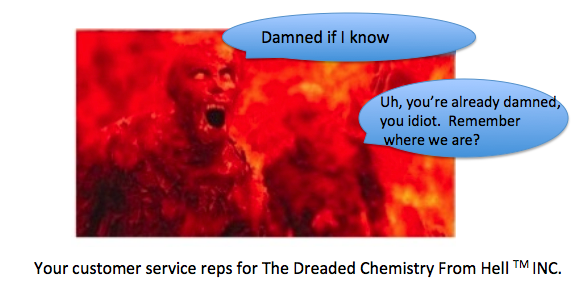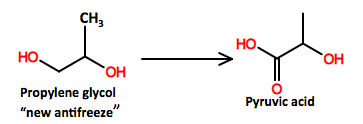
What's worse? A worldwide pandemic or a chemistry lesson? I supposed that depends upon your particular internal guidance systems, but I estimate that the general population would be about 50-50 here if asked. Let's ask a couple of experts.

OK, that wasn't very helpful. Let's just continue.
Chemists are certifiably weird, and chemistry can be pretty weird too. But biochemistry, especially when it pertains to the human metabolism of chemicals and drugs, can be even weirder. How else can you explain the profound biological difference between three very similar different diols – compounds containing two hydroxyl (OH) groups?
All three are sweet. Two are used as antifreeze; one of these is toxic, and the other safe enough to eat. The third isn't used as an antifreeze (although it could be), but when swallowed, it is converted to GHB, a powerful sedative that is one of the "date rape" drugs (1).
But the three chemicals all have one primary thing in common. Their biological effects are not from the chemicals themselves; it is from their metabolites.
1. Ethylene Glycol (antifreeze)
Ethylene glycol, aka 1,2-ethanediol, differs from drinking alcohol by one oxygen atom. The chemical itself belongs to a class of chemicals called sugar alcohols. Not surprisingly, it is sweet (2), but you don't want to drink it. Ethylene glycol itself is not very toxic, but thanks to your liver, it is metabolized to oxalic acid, which is quite toxic.

The sweetness of ethylene combined with its metabolism is what makes it dangerous, especially to pets and wild animals that will lick puddles of antifreeze from a leaky car radiator. If children get their hands on it, they will also get into trouble. In 2012 there were 6,000 cases of ethylene glycol poisoning, mostly in children.
To prevent the poisoning of children, some household products have a bittering agent added to them. Strangely, this had no effect on antifreeze ingestion in infants. The study authors were mystified by their own findings. So am I.
2. Propylene Glycol (safe antifreeze)
You'd have to be a chemist (or some other mutant life form) to even suspect that the addition of one carbon atom to ethylene glycol would convert it into something you can drink (3), but that's the case.

This is because pyruvic acid, the metabolite of propylene glycol, is GRAS (4) and commonly used in foods. And why not? It is "a food." Pyruvic acid is one of the components of the Krebs (citric acid) cycle – a complicated series of biochemical transformations used to generate energy.
I wasn't kidding about it being food. You can even buy the Kosher version of the stuff.

Source: Sigma-Aldrich
Propylene glycol, which also lowers the freezing point of water, has largely replaced ethylene glycol in antifreeze products.
3. 1,4-Butanediol (BDA)
Having suffered through this much torture, one would hope that you've at least picked up on a trend because the same thing happens to 1,4-butanediol (BDA) – a compound that has one more carbon atom than propylene glycol. Indeed, 1,4-butanediol, a common industrial chemical, is metabolized (oxidized) by the liver to form gamma-hydroxybutyric acid - one of the date rape drugs.

One of the two hydroxyl groups of 1,4-butanediol is oxidized to a carboxylic acid forming GHB.
So, there's your chemistry lesson!
Now you can drink a food additive that is pretty much harmless (pyruvic acid), potentially deadly (ethylene glycol), or can put you into a coma (BDA).
Most people who make it through these chemistry lessons choose one of the last two.
NOTES:
(1) The other is Rohypnol or roofies, a powerful Valium-like drug.
(2) It's fairly safe to say that just about any molecule that has a bunch of hydroxyl groups is sweet. Sucrose has eight of them.
(3) You can, but you shouldn't. Even a food component can be fatal if a lot of it is consumed. Besides, drinking out of bottles that come from a chemical supplier is generally thought of as a bad habit.
(4) GRAS means generally recognized as safe. The term means that it is exempt from the Federal Food, Drug, and Cosmetic Act and can be added to food without regulation.



